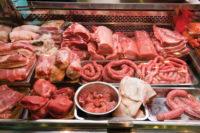Food Chemical May Impact Girls’ Growth

The Jersey Girl Study at the Cancer Institute of New Jersey is among the first to look at the effects on healthy girls of Zeranol, a synthetic chemical used to boost meat production, and its natural form, zearalenone, a fungus found in contaminated grains. These fungi mimic estrogen in the body.
The results suggest that they may delay height growth and breast development in girls --contrary to what researchers expected to find, said Dr. Elisa Bandera, an epidemiologist and the study’s lead researcher.
“The message right now is we need to do more research,” Bandera said. The study was based on an analysis of urine samples from 163 girls, aged 9 and 10.
“Surprisingly, little is known about the health effects of these mycoestrogens, including their impact on puberty in girls,” the study said.
The study is one of many across the country to examine environmental factors related to early puberty, which increases the risk of breast cancer later in life. Girls who have their first period before age 11 are at triple the risk for breast cancer, compared to those who have it after.
The reason is estrogen -- the greater the lifelong exposure to estrogen, the greater the risk of breast cancer. The years between a girl’s first period and her first pregnancy appear to be a time of particular vulnerability to mutation or environmental damage.
“Several groups are looking at the impact of pubertal timing from early environmental exposures,” said Dr. Frank Biro, who heads one center of the federally funded “breast cancer and the environment research program,” at the Cincinnati Children’s Hospital Medical Center.
His 2010 study of 1,200 girls, found the onset of puberty has dropped among American girls, with many as young as 7 and 8 showing signs of breast development. That is linked to increasing weight at a young age, as well as chemicals in the environment.
Young girls’ exposure to three classes of chemicals -- phenols, phthalates, and phytoestrogens -- can disrupt the timing of puberty and set them up for later health problems, researchers at the Mount Sinai School of Medicine found. These chemicals are found in plasticizers, used in bottles, can coatings and time-released medications; in nail polishes, to increase durability; and in perfumes, lotions and shampoos, to carry fragrance.
Bandera said she was interested in the effects of hormones in meat on healthy girls. The synthetic form of the fungus she studied is banned for use in the European Union but widely used in the U.S. as a growth enhancer for cattle.
The natural form is regulated in Europe, where its level in food must fall below certain levels. In the U.S., “they’re giving this hormone to affect meat production and growth, so I thought it has to affect growth in girls,” Bandera said.
The Jersey Girl Study results showed:
* The substances were detected in 78% of the urine samples. The natural form appeared in 55% of the girls, and the synthetic form in more than 20%.
* Girls who ate popcorn or beef the day before the urine test had higher levels of the fungal hormones, the results showed.
*Girls whose urine contained the fungal hormones were shorter and less likely to have started developing breasts than their counterparts. The girls without the substances in their urine were taller and more likely to have reached the onset of breast development.
The results “were the opposite of what we anticipated,” Bandera said. However, the effect seems similar to that of isoflavones, a plant-based hormone disruptor found in soy products, she said. Soy isoflavones attach to estrogen-receptors, competing with estrogen produced by the body.
The study is published in the November 15 edition of Science of the Total Environment and is online now.
Some previously published studies suggested that fungal estrogens may be “a triggering factor” for precocious puberty. One study of 32 girls in Italy who were under treatment for precocious puberty (before age 7) detected the compounds in six of the girls, even though their use is banned or regulated there.
Larger studies, following the effects over a number of years, are needed, she said.
From the November 2, 2011, Prepared Foods' Daily News.
Looking for a reprint of this article?
From high-res PDFs to custom plaques, order your copy today!




